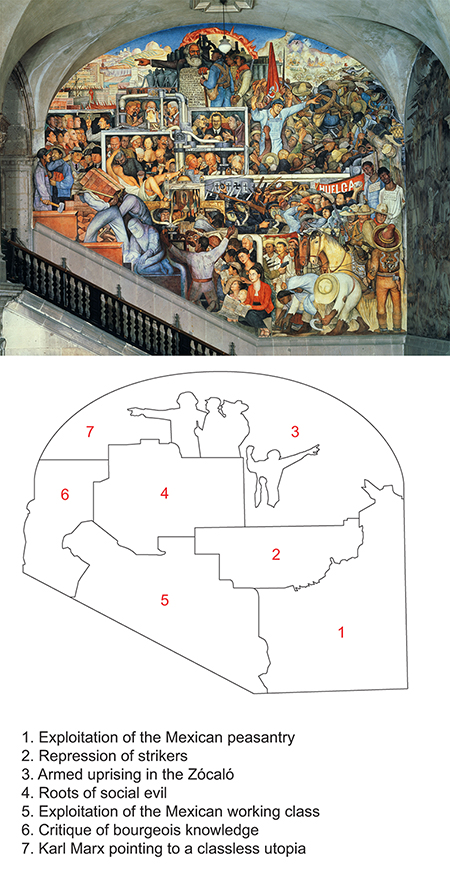3 The mural described
The iconography of the main wall (the west wall), the first that the viewer sees when ascending the stairs, is framed within a depiction of the two major nineteenth-century invasions of Mexico: by the United States in 1847 (in the upper part of the bay on the far right); and by the French in 1862–67 (in the bay on the far left). In the upper portion of the three central bays, Rivera depicted, from left to right, The Porfirian Era (1876–1911), The Legacy of Independence (1810–1930) and Reform and the Era of Benito Juárez (1855–76).
Although each section includes a cast of historical figures, Rivera does not focus upon anyone in particular. Instead, the Mexican people are themselves represented as the anonymous agents of social change, painted in what David Craven has described as a ‘post-heroic’ way (Craven, 2002, p. 55). A significant exception to this emphasis upon the non-hierarchical is the depiction of the revolutionary peasant leader Zapata, who appears twice in the central wall. Below the upper register of these five bays, Rivera painted a kaleidoscopic arrangement of scenes and figures from the conquest through to the early colonial period. Importantly, he neither idealised pre-Columbian Indians nor represented them as mere victims of history, and added scenes of human sacrifice as well as resistance to the invading Spanish forces between 1519 and 1521.
These themes tie the iconography of the main wall to the north wall, which depicts the Aztec world. Here, the central iconographic feature is Quetzalcóatl – the important Meso-American mythological figure – in front of an Aztec pyramid. Arranged around him are a seated group of white-robed admirers as well as other figure groups that, taken together, depict the productivity and sophistication of pre-Columbian civilisation. Again, any idea that the pre-Hispanic world was some sort of Edenic paradise is offset by the inclusion of certain iconographic elements.
On the left, Rivera painted a scene which shows figures from conquered tribes climbing a pyramid with loaded woven baskets on their backs as tribute to an Aztec priest, and, below this, armed resistance to Aztec warriors dressed in military costumes. The conflict depicted here, and the ensuing one between the Aztecs and the Spanish conquistadores, is portended above in the detail of Quetzalcóatl fleeing eastwards on a huge feathered serpent. This provides another useful thematic link to the central wall in that, according to certain accounts, Quetzalcóatl vowed to return on the anniversary of his birth in 1519, the very year that Cortés arrived, thereby ironically facilitating a welcome reception for the Spanish invaders.
Directly opposite this depiction of the Aztec world is Mexico Today and Tomorrow. Employing a grid-like system, this wall is the most tendentious. In the bottom right corner it depicts: campesinos (tenant farmers) labouring in a field under the watchful eyes of armed overseers; two murdered campesinos above them, one hanged for being a communist and the other for being an agrarian reformer; fascist-looking police suppressing a strike; above that a worker addressing a crowd; and at the top there is a pitched battle in the Zócalo. In the compartmentalised middle section, just left of centre, Rivera portrays the forces of reaction: top left, corporate barons in the United States hunched around a ticker tape; to their right, Calles surrounded by reactionary representatives of the army and the clergy; below them, corrupt journalists; and then, to their left, figures representing decadent high society.
Socialist education is a key theme on this wall, with the two Kahlo sisters – Frida and Cristina – instructing children in the writings of Karl Marx at the bottom centre; a figure on the far left holding a copy of Marx’s Capital and ridiculing a university lecturer espousing reactionary ideas; and, at the top in the centre, the figure of Marx himself holding a scroll with passages from the 1848 Communist Manifesto. He is instructing the triad of soldier, worker and peasant while pointing out of the mural to the left, over a utopian landscape with fully harmonised industrial and agricultural scenes.



